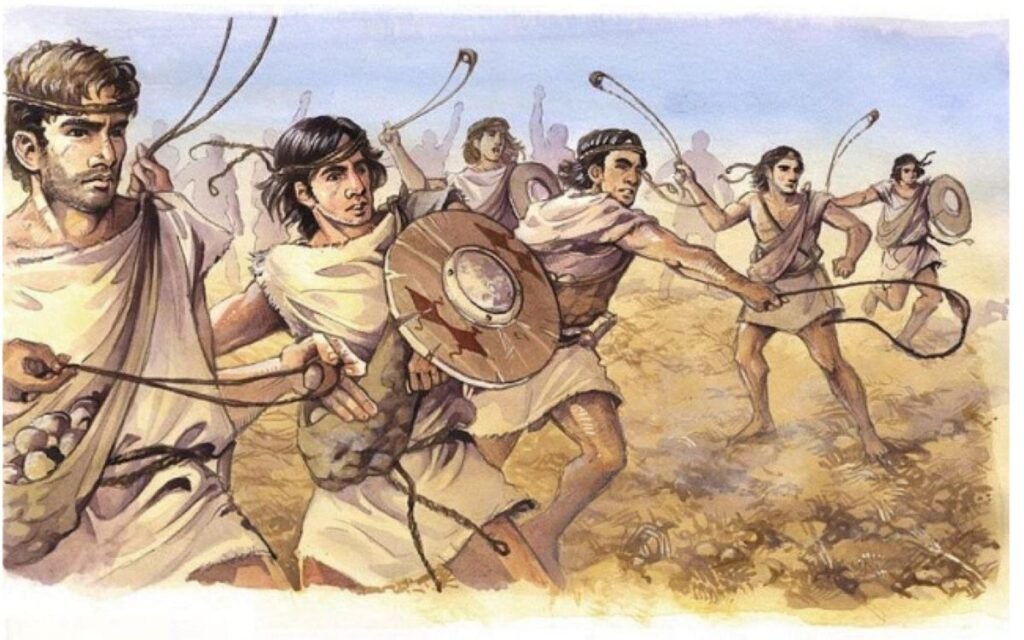We have all heard the story of the shepherd who, armed with nothing but a sling, faces off with the giant Goliath and topples him. It is the quintessential biblical underdog story, often shown as a miracle of faith beating strength.
But what if I told you that little David did not just get a stroke of divine intervention and that he, in fact, brought the ancient equivalent of a firearm to a sword fight?
Hold on to your hat; it’s about to get interesting.
The Sling is Antiquity’s Firearm
Alright, hear me out!
In the history of ancient warfare, the sling was not a child’s plaything. This simple device made with two cords and a pouch was the forte of specialized fighters who would hone their skills since they were children.
The projectiles, or stone bullets used, were carefully selected and, in some cases, even shaped by the slingers to better fly and deliver damage over distances exceeded only by specialized archers.
Historical accounts and archaeological evidence show that skilled slingers were renowned, and their skills were highly respected. Some examples include:
- Balearic Slingers (from modern-day Mallorca, Menorca, and Ibiza)—These were elite slingers from the 5th century BCE to the Roman times. They were known for exceptional accuracy and impressive range. They trained from childhood and had to hunt their food with slings if they were to eat. Their fame saw them attract offers to become mercenary units across the ancient world.

Balearic slingers in action: credit- dzen.ru
- Rhodian Slingers (Island of Rhodes, Aegean Sea) – These slingers lived in Classical Greece and were prominent in the Peloponnesian War (431 to 404 BCE). Rhodian slingers could out-range archers, delivering precise strikes from afar. Their homeland’s rocky terrain likely contributed to this proficiency.
- Roman Funditores – The Romans used slingers called Funditores, some from the Balearic Islands, to disrupt formations during battle and harass enemies from afar.
There are more examples, but we have a fight to get to.
Let’s break it down.
Range Could Save Your Life
Slingers can throw a stone a mind-blowing 300+ meters, and in ancient combat, keeping distance was THE strategy. David might have gone out there without armour and seemed all but unarmed, but he was far from it.
We get evidence of David’s skill with the sling and combat from 1st Samuel 17:34 onwards, where it says:
David said, “I’ve been a shepherd, tending sheep for my father. Whenever a lion or bear came and took a lamb from the flock, I’d go after it, knock it down, and rescue the lamb. If it turned on me, I’d grab it by the throat, wring its neck, and kill it. Lion or bear, it made no difference—I killed it. And I’ll do the same to this Philistine pig who is taunting the troops of God-Alive. GOD, who delivered me from the teeth of the lion and the claws of the bear, will deliver me from this Philistine.” Saul said, “Go. And GOD help you!”
Clearly, the boy was not too familiar with fear at this point.
A Sling Could Inflict Fatal Damage
At a speed of about 130 miles per hour, if a slinger’s stone hits anywhere important, you are pretty much dead. The impact of a sling projectile could inflict severe damage, including bone fractures and internal trauma.
Some of these stone or lead bullets could penetrate some forms of armour if they caught the right chink. However, Goliath was armoured that day, and the Israelites tried to armour David too, but he refused so he could remain mobile during the fight.
The Phillistine’s armour is described as such in 1st Samuel 17:5-15
He had a bronze helmet on his head and wore a coat of scale armour of bronze weighing five thousand shekels; on his legs, he wore bronze greaves, and a bronze javelin was slung on his back. His spear shaft was like a weaver’s rod, and its iron point weighed six hundred shekels. His shield bearer went ahead of him.
5k shekels is like 90 pounds, and at that level, it would not have been penetrated easily or exposed the wearer to much danger except for the exposed parts. While there were a few spots left unguarded on the giant, he had a shield and knew how to crouch behind it.
Goliath’s Strategy
It is thought that Goliath was planning to fight David with a sword, but that is not likely. Let’s go back to the bible and look at our last verse, which offers the last clue:
David ran and stood over him. He took hold of the Philistine’s sword and drew it from the sheath. After he killed him, he cut off his head with the sword. When the Philistines saw that their hero was dead, they turned and ran.
The hidden detail here is that his sword was still in its scabbard when the giant fell. As a close-quarters combat weapon, you had to wait until you were right next to the thing or person you wanted to cut to draw it.
From the distance he was at, Goliath’s strategy would have been to hurtle towards the puny herder, clocking the distance as he went, and then unleashing his gigantic javelin, which at 90 pounds, thrown by a freak of nature, would almost certainly pierce through armour or shields.
Goliath probably killed more people this way than he did with a sword.
David would have needed to stop, plant his feet, and start swinging his sling to build momentum. That ruled out running around peppering the giant with stones.
David would also have probably brought a special set of stone bullets for this fight, but on that day, the most important stones he was going to need would be the one he was born with.
Let The Battle Commence
So picture it: You are David and have come out to challenge the giant. He starts to move closer, and the fight has already begun. You can bail out, but you are convinced you have the “Lord of hosts, the God of the armies of Israel,” at your back and have killed a lion and bear recently so, you are feeling pretty good.
To bait the giant, you have to wait. He is coming at you still, closing the distance, spear in hand, with his shield up.
You hold your ground still and wait until he is close enough to continue closing in, but with enough time to load your stone and start whirling the sling. He sees it; it doesn’t faze him. As a warrior, he knows how dangerous slings are, but this puny boy?
As he gets even closer, you can almost tell he is relishing the encounter, sure that at the distance he is at, the javelin will likely go straight through your body and pin you to the ground.
Still, you wait. That is, until he raises his shield, slows down, plants his body, and swings his body and arm back. In a moment, the spear will come flying at you.
But, at the same moment, your arm swinging the sling snaps forward in a perfect shot that seeks out that smallest of targets; a small gap between the top of his shield and the bottom of his helm.

David slings Goliath: credit- dzen.ru
This would have been when his concentration shifted from shield to spear. The spear leaves his hand, but not before his head tilts backward violently. He’s been hit and will not survive encountering the lion slayer of the tribe of Judah.
It is done. Your courage and the Lord of hosts has seen you through. The story of David and Goliath is a story about courage. Never forget that.











